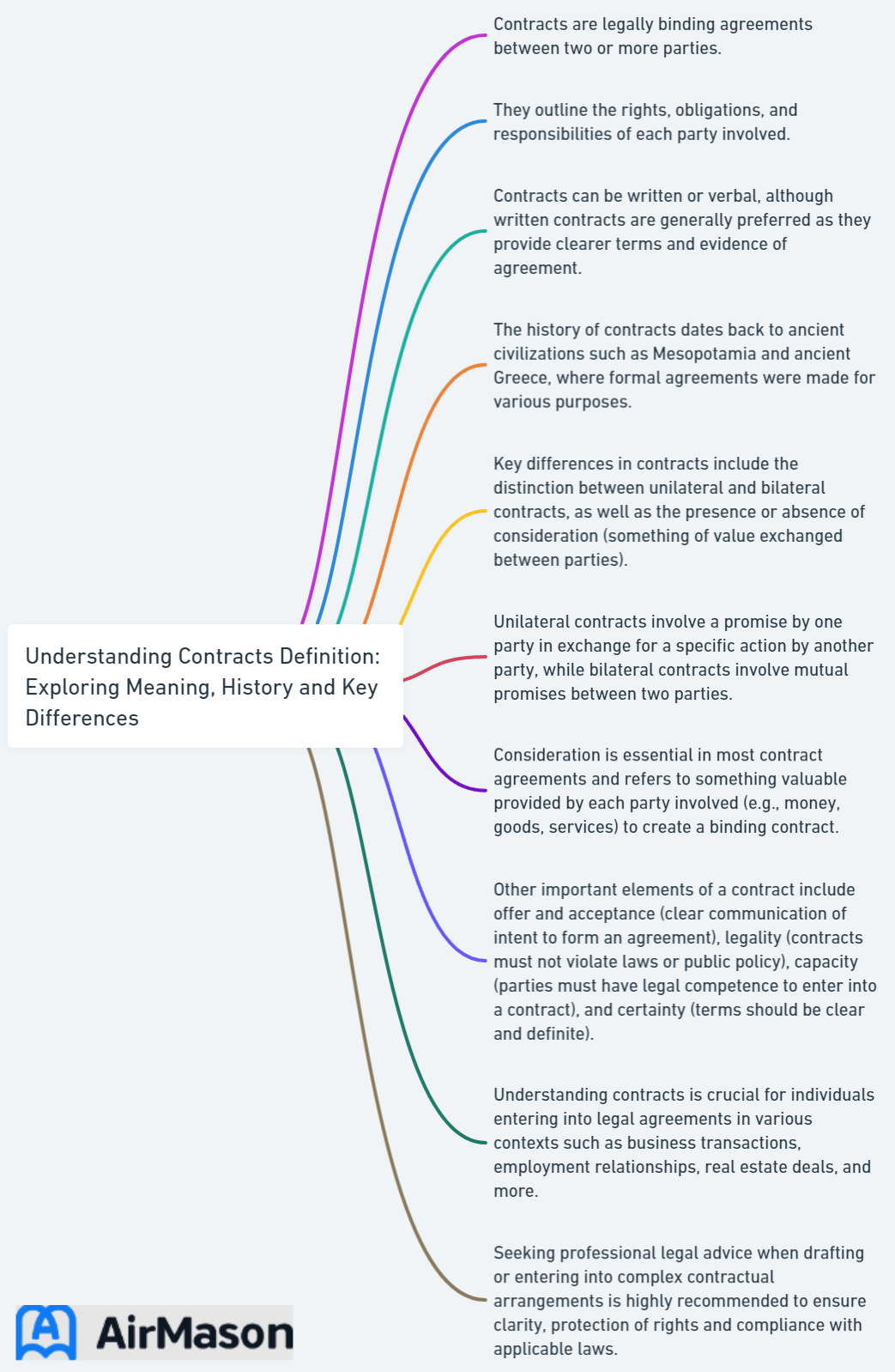
Have you ever wondered about the intricacies of contracts and how they govern our daily lives? From buying a car to signing an employment agreement, contracts play a crucial role in various transactions. In this blog post, we’ll explore the contracts definition, meaning, history, and key differences of contracts, as well as practical applications, challenges in contract formation, and international contracts. Get ready to dive deep into the world of contracts and broaden your understanding!
Key Takeaways
- This article provides an in-depth look at contracts, from elements and types to legal requirements and enforceability concerns.
- Common law vs civil law systems have distinct contract formation and enforcement requirements. Agreements are not legally binding while contracts are enforced by the court system.
- Contracts provide a secure framework for managing transactions & relationships, with electronic signatures providing efficient execution of agreements in the digital age. International considerations must be taken into account when drafting cross border sales contracts.
Defining Contracts: A Comprehensive Look
A contract is a legally binding agreement between two or more parties, encompassing various types of transactions, such as sales, employment, and insurance policies. The essence of contract law lies in the mutual assent of two or more persons, who enter into a bilateral contract with the intent to create legal obligations. From labor contract negotiations to book deals, contracts permeate our daily lives and serve as the foundation of countless transactions.
Different legal systems around the world recognize various types of contracts, each with its unique characteristics and requirements. Whether it’s a written contract, oral contract, or even a contract implied by the conduct of the parties, the enforceability of such a contract depends on the presence of specific elements and adherence to the applicable legal framework.

Contract Elements
The essential elements of a contract include:
- Offer: a proposal made by one party to another, indicating a willingness to enter into a contractual relationship.
- Acceptance: assenting to the terms stipulated in the agreement.
- Consideration: something of value exchanged between the parties, such as money, goods, or services.
- Mutual intent to be bound: the intention of contracting parties to be legally bound by the terms of the contract.
Forming a contract between two or more parties hinges on these elements. The objective approach to contractual intent interprets the intention of contracting parties as seen from the perspective of a reasonable person.
Another key component of a contract is consideration, often defined as “the price for which the promise of the other is bought”. Various forms of consideration are accepted, including:
- Conferring a benefit to the promisor
- Incurring a detriment to the promisee
- Forbearance to act, provided that a legal right is surrendered in the process
In most United States jurisdictions, firm offers are valid without consideration.
Certain requirements need to be fulfilled for a contract to be considered a valid contract and legally enforceable in the United States. For example:
- A written contract is necessary for tangible product sales in excess of $500
- Real estate contracts must be in writing
- An oral contract is generally valid and legally binding if it isn’t mandated by law to be written
Even though it is a prior contract, it is still considered a legally binding contract.
Types of Contracts

There are various categories of contracts, including:
- Complete or incomplete contracts
- Standard form contracts
- Construction contracts
- Transport contracts
Complete contracts give the parties the benefit of predicting and carefully specifying their roles, duties, and outcomes in any situation. In contrast, incomplete contracts do not provide such foresight. Standard form contracts are widely used today. They involve one party providing the text of a contract using a pre-existing template, which in turn does not permit any scope for the other party to negotiate its terms.
Construction and transport contracts refer to contractual arrangements employed in the execution of construction-related activities and the transport of goods and passengers, respectively. International agreements, such as the ASEAN Framework Agreement on Multimodal Transport, provide standardized terms governing multimodal transport contracts within specific regions.
Various legal systems recognize the pacta sunt servanda principle, which dictates that all serious agreements ought to be enforced, regardless of adherence to stringent formalities prescribed by secular law.
The Evolution of Contract Law

The development of contract law is deeply rooted in the history of human societies, with early societies relying on kinship or religion for enforcement, and modern societies utilizing legal systems to enforce commitments. In primitive societies, most transactions were self-enforcing, as the transaction was concluded on both sides simultaneously. However, the advent of market economies necessitated a legal framework of contracts to facilitate commerce and ensure adherence to commitments.
Common law jurisdictions, such as English-speaking countries, trace their contract law back to the now-defunct writ of assumpsit, while civil law jurisdictions typically trace their contract law to Roman law. Roman law played a significant role in the development of contract law in western Europe, recognizing various types of contracts and agreements, some of which were enforceable, while others were not.
Roman Law Contributions
Roman law greatly influenced the development of contract law in western Europe, as it acknowledged various types of contracts and agreements, some enforceable and others not. At its ultimate stage of evolution, Roman law implemented informal executory contracts—namely, agreements to be fulfilled after they were formed.
This recognition of different types of contracts and agreements allowed for more complex and diverse transactions, fostering the growth of commerce and trade throughout the region. The legacy of Roman law can still be seen today in the distinctions between civil law and common law jurisdictions, as well as the various types of contracts recognized and enforced by modern legal systems.
Common Law vs. Civil Law
The rules of contracts vary between jurisdictions due to differences in legal systems, such as:
- English common law
- Roman law
- Napoleonic Code
- Roman-Dutch law
English-speaking countries derive their contract law from English contract law, while civil law jurisdictions typically trace their contract law to Roman law.
These different legal systems have varying requirements for contract formation and enforcement, with some jurisdictions placing more emphasis on certain elements of contracts than others. The will theory of contract law has been completely revamped. It is now understood as a mutual consent between both parties, wherein each party’s promise is considered to be a declaration of their will, and not morally binding. Understanding these differences is crucial when engaging in transactions across different legal systems, as it ensures the proper formation and enforcement of contracts.
Key Differences Between Agreements and Contracts

While the terms “agreement” and “contract” are often used interchangeably, it’s important to understand the key differences between the two.
An agreement is an informal promise or arrangement between parties that lacks legal enforceability, while a formal contract is a legal arrangement with enforceable terms and conditions. In some cases, parties may choose to enter into such an agreement rather than a formal contract.
For an agreement to become a contract, all the necessary components of a contract, such as:
- offer
- acceptance
- consideration
- capacity
- legality
must be satisfied.
Comprehending this distinction is vital to ascertain that parties initiate legally binding relationships when required and preferred.
Practical Applications of Contracts

Contracts are used in various contexts, serving as the backbone of countless transactions and relationships. For instance, employment agreements outline job responsibilities and compensation, while sales contracts detail the terms of a transaction. In each of these situations, contracts provide a legally enforceable framework that defines the rights and contractual obligations of the involved parties, ensuring that both parties are protected and held accountable for their commitments.
Grasping the practical applications of contracts is key to managing daily transactions and relationships. From hiring a new employee to purchasing a car, contracts serve as a necessary tool for establishing clear expectations, managing risk, and ensuring that both parties are on the same page regarding their rights and responsibilities.
Employment Contracts
Employment contracts play a vital role in defining the relationship between an employer and employee, including job duties, compensation, and termination provisions. Job duties are particularly important, as they delineate the precise tasks and obligations that an employee is expected to carry out. By clearly defining these duties, employers can assess whether the employee is adhering to the expectations laid out in the contract.
Termination provisions are another crucial aspect of employment contracts, typically stipulating that either the employee or the company may end the employment relationship at any time, with or without cause. It’s critical for both employers and employees to comprehend these provisions as they lay out a guideline for ending an employment relationship and safeguarding both parties during a conflict.
Sales Contracts
Sales contracts outline the terms and conditions of a sale, including payment terms, delivery, and warranties. These contracts play a crucial role in transactions, as they establish clear expectations for both the buyer and the seller, ensuring that both parties understand their rights and responsibilities.
For example, a delivery clause in a sales contract outlines the terms and conditions related to the delivery of the goods or products being sold, specifying the responsibilities and obligations of both the buyer and the seller regarding the delivery process.
Warranties are another important aspect of sales contracts, providing assurance to the buyer that the goods or products being sold meet certain standards or criteria. Both buyers and sellers must comprehend the various types of warranties and their implications, as they serve as a tool for risk mitigation and protection in case of a dispute or disagreement.
Challenges and Considerations in Contract Formation
When creating a contract, parties must consider various challenges and considerations, such as enforceability, drafting, and jurisdictional issues. Ensuring that a contract is enforceable is of paramount importance, as it guarantees that the parties’ rights and interests are safeguarded. To mitigate enforceability concerns, contracts must encompass all necessary elements like:
- Offer
- Acceptance
- Consideration
- Capacity
- Legality
Another vital factor is drafting a contract, where explicit and succinct language is required to prevent ambiguity and potential conflicts. Parties should take care to address all relevant terms and conditions in their contracts, ensuring that the document accurately reflects their intentions and expectations. Additionally, jurisdictional issues must be considered, particularly in international contracts, as different legal systems may have varying requirements for contract formation and enforcement.
Enforceability Concerns
Contracts must contain all essential elements and comply with applicable laws to be enforceable in court or arbitration. The objective approach to contractual intent interprets the intention of contracting parties as seen from the perspective of a reasonable person, ensuring that the contract accurately reflects the parties’ intentions. In addition, the mirror image rule dictates that the offer and acceptance must not deviate from the offer’s terms, further contributing to the enforceability of a contract.
To create a legally enforceable contract, parties must ensure that all necessary elements are satisfied, such as:
- Offer
- Acceptance
- Consideration
- Capacity
- Legality
By carefully considering these factors and adhering to the applicable legal framework, parties can create contracts that are legally binding and enforceable in the event of a dispute or disagreement.
Drafting Tips
When drafting a contract, parties should ensure that the document is clear and concise, addressing all relevant terms and conditions and avoiding ambiguous language. This not only helps to prevent misunderstandings and disputes but also contributes to the enforceability of the contract.
By carefully considering the following factors, parties can create a well-structured and legally sound contract that accurately reflects their intentions and expectations:
- The language used
- The format of the contract
- The parties involved
- The terms of the contract
- Any applicable laws or regulations
Electronic Contracts and E-Signatures

With the rise of e-commerce and digital transactions, electronic contracts have become increasingly prevalent and legally valid. These contracts are formal legal arrangements with enforceable terms and conditions, just like traditional paper-and-ink contracts. Many jurisdictions have passed e-signature laws to simplify the use of electronic contracts and ensure their legal validity. E-signatures are digital signatures employed to authenticate and validate electronic contracts, providing a secure and efficient means of executing agreements in the digital age.
Electronic contracts possess the same legal standing as traditional paper-and-ink contracts in the United States and many other countries. The use of electronic contracts and e-signatures has facilitated the creation, storage, and enforcement of contracts while decreasing the cost and time associated with traditional paper-and-ink contracts.
As the world continues to embrace digital technology, electronic contracts and e-signatures are expected to play an increasingly important role in various transactions and relationships. Comprehending the legal implications and stipulations of electronic contracts is key for both individuals and businesses, safeguarding their rights and interests in the digital domain.
International Contracts and Jurisdictional Issues
Different legal systems have varying requirements for contract formation and enforcement, with international contracts often subject to additional provisions and jurisdictional considerations. For instance, the Convention on Contracts for the International Sale of Goods (CISG) governs international sales contracts, providing uniform rules for contract formation, delivery, obligations, and remedies. Additionally, jurisdictional issues such as the selection of a governing law, the choice of a forum, and the recognition of foreign judgments must be carefully considered in order to guarantee the protection of the parties’ rights and interests.
It’s imperative for businesses and individuals involved in cross-border transactions to comprehend the challenges and considerations in forming international contracts. By taking into account the various legal systems and jurisdictional issues, parties can create enforceable contracts that accurately reflect their intentions and expectations, ultimately fostering successful international business relationships.
CISG and Cross-Border Sales
The Convention on Contracts for the International Sale of Goods (CISG) is a multilateral treaty that prescribes the rules governing contracts for the international sale of goods between private businesses. It seeks to foster equilibrium between the interests of the buyer and seller, thereby stimulating international trade. The CISG applies to cross-border sales when the seller and the buyer have their respective places of business in different Contracting States.
The CISG provides a legal regime that applies to contracts for the cross-border sale of goods between private businesses, ensuring that consistent rules and principles are adhered to across different jurisdictions. This promotes predictability and reduces impediments to international trade. By understanding and adhering to the provisions of the CISG, parties involved in international sales contracts can navigate the complexities of cross-border transactions with greater ease and confidence.
Summary
Contracts are the backbone of countless transactions and relationships, governing everything from employment agreements to international sales contracts. Understanding the intricacies of contract formation, enforceability, and jurisdictional considerations is essential for ensuring that your rights and interests are protected. As the world continues to evolve and embrace new technologies, electronic contracts and e-signatures promise to play an increasingly important role in our daily lives. By staying informed and adapting to these changes, you can confidently navigate the complex world of contracts and ensure successful transactions and relationships.
Frequently Asked Questions
What is a simple definition of a contract?
A contract is an agreement between two parties that creates mutual obligations, which are enforceable by law. It requires mutual assent, expressed by a valid offer and acceptance, along with adequate consideration and legal capacity.
What is the difference between a contract and an agreement?
Agreements can be informal and do not require formal documentation, while a contract is a more legally binding and documented arrangement between parties. Both an agreement and contract represent specific arrangements between two or more parties.
What are the 4 types of contracts?
The four main types of contracts are Sales Agreements, Non-Disclosure Agreements and Intellectual Property Management, Professional Service Agreements, and Adhesion Contracts.
What are the essential elements of a contract?
The essential elements of a contract are offer, acceptance, consideration, and mutual intent to be bound, creating an enforceable agreement.
Are electronic contracts legally valid?
Yes, electronic contracts are legally valid and possess the same legal standing as traditional paper-and-ink contracts in many jurisdictions, thus ensuring their enforceability.